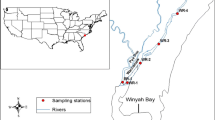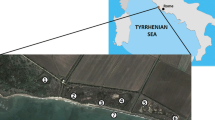Abstract
In response to a major influx of freshwater to the Mississippi Sound following the opening of the Bonnet Carre Spillway, water samples were collected from three sites along the Mississippi shoreline to assess the impact of altered salinity on three pathogenic Vibrio species. Salinity readings across the affected area during the 2011 sample period ranged from 1.4 to 12.9 ppt (mean = 7.0) and for the 2012 sample period from 14.1 to 23.6 ppt (mean = 19.8). Analyses of the data collected in 2011 showed a reduction in densities of Vibrio parahaemolyticus and Vibrio vulnificus with a concurrent increase of Vibrio cholerae numbers, with V. cholerae becoming the only Vibrio detected once salinity readings dropped to 6 ppt. Follow-up samples taken in 2012 after recovery of the salinity in the sound showed that the relative densities of the three pathogenic vibrios had reverted back to normal levels. This study shows that although the spillway was open but a few weeks and the effects were therefore time limited, the Mississippi River water had a profound, if temporary, effect on Vibrio ecology in the Mississippi Sound.



Similar content being viewed by others
References
Daniels NA (2000) A review of pathogenic Vibrio infections for clinicians. Infect Med 17:665–685
Oliver JD (2006) Vibrio vulnificus. ASM, Washington, D.C
CDC (2006) Two cases of toxigenic Vibrio cholerae O1 infection after Hurricanes Katrina and Rita—Louisiana, October 2005. MMWR Morb Mortal Wkly Rep 55:31–32
CDC (2011) COVIS annual summary, 2009. Atlanta, GUDoHaHS, CDC, Atlanta
DePaola A, Presnell MW, Motes ML, McPhearson RM, Twedt RM, Becker RE, Zywno SR (1983) Non-01 Vibrio cholerae in shellfish, sediment and waters of the U.S. Gulf Coast. J Food Prot 46:802–806
Ghose AC (2011) Lessons from cholera & Vibrio cholerae. Indian J Med Res 133:164–170
CDC (2011) Disaster recovery fact sheet. NCfE Health, Centers for Disease Control and Prevention, Atlanta
Prouty MG, Kolose KE (2006) Vibrio cholerae: the genetics of pathogenesis and environmental persistence. In: Thompson FL, Austin B, Swings J (eds) The biology of vibrios. ASM, Washington, D.C
Faruque SM, Albert MJ, Mekalanos JJ (1998) Epidemiology, genetics, and ecology of toxigenic Vibrio cholerae. Microbiol Mol Biol Rev 62:1301–1314
Colwell RR, West PA, Maneval D, Remmers EF, Elliot EL, Carlson NE (1984) Ecology of the pathogenic Vibrios in Chesapeake Bay. In: Colwell RR (ed) Vibrios in the environment. Wiley, New York
Farmer JJ, Janda JM (2005) Order XI. Vibrionales. In: Garrity GM (ed) Bergey's manual of systematic bacteriology, 2nd edn. Springer, New York, pp 491–555
Caldini G, Neri A, Cresti S, Boddi V, Rossolini GM, Lanciotti E (1997) High prevalence of Vibrio cholerae non-O1 carrying heat-stable-enterotoxin-encoding genes among Vibrio isolates from a temperate-climate river basin of central Italy. Appl Environ Microbiol 63:2934–2939
Igbinosa EO, Okoh AI (2209) Toxigenic Vibrio cholerae strains and their associated malaises. Afr J Microbiol Res 3:200–211
Nandi B, Nandy RK, Mukhopadhyay S, Nair GB, Shimada T, Ghose AC (2000) Rapid method for species-specific identification of Vibrio cholerae using primers targeted to the gene of outer membrane protein OmpW. J Clin Microbiol 38:4145–4151
Nordstrom JL, Vickery MC, Blackstone GM, Murray SL, DePaola A (2007) Development of a multiplex real-time PCR assay with an internal amplification control for the detection of total and pathogenic Vibrio parahaemolyticus bacteria in oysters. Appl Environ Microbiol 73:5840–5847. doi:10.1128/AEM.00460-07
Warner EB, Oliver JD (2008) Multiplex PCR assay for detection and simultaneous differentiation of genotypes of Vibrio vulnificus biotype 1. Foodborne Pathog Dis 5:691–693. doi:10.1089/fpd.2008.0120
Russek E, Colwell RR (1983) Computation of most probable numbers. Appl Environ Microbiol 45:1646–1650
Morris JG Jr, Picardi JL, Lieb S, Lee JV, Roberts A, Hood M, Gunn RA, Blake PA (1984) Isolation of nontoxigenic Vibrio cholerae O group 1 from a patient with severe gastrointestinal disease. J Clin Microbiol 19:296–297
US-FDA (2009) NSS Program guide for the control of molluscan shellfish. US-FDA, Silver Spring
Singleton FL, Attwell R, Jangi S, Colwell RR (1982) Effects of temperature and salinity on Vibrio cholerae growth. Appl Environ Microbiol 44:1047–1058
Huq A, Colwell RR, Rahman R, Ali A, Chowdhury MA, Parveen S, Sack DA, Russek-Cohen E (1990) Detection of Vibrio cholerae O1 in the aquatic environment by fluorescent-monoclonal antibody and culture methods. Appl Environ Microbiol 56:2370–2373
Acknowledgments
Special thanks go to Dawn Rebarchik, Misty Fiello, Becky Hardgrove, Adrienne Flowers, Halley Murray, Nicholas Noriea III, Rachelle Williams, and summer interns Melissa Baker and Patrick Auquin for their assistance in sample collection and processing. This work was supported by National Science Foundation grant EF-0813285/EF-1003943 as part of the joint NSF-NIH Ecology of Infectious Diseases Program.
Author information
Authors and Affiliations
Corresponding author
Rights and permissions
About this article
Cite this article
Griffitt, K.J., Grimes, D.J. Abundance and Distribution of Vibrio cholerae, V. parahaemolyticus, and V. vulnificus Following a Major Freshwater Intrusion into the Mississippi Sound. Microb Ecol 65, 578–583 (2013). https://doi.org/10.1007/s00248-013-0203-6
Received:
Accepted:
Published:
Issue Date:
DOI: https://doi.org/10.1007/s00248-013-0203-6




